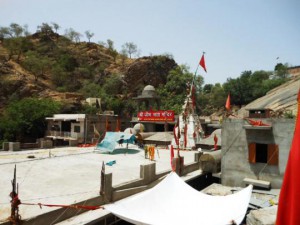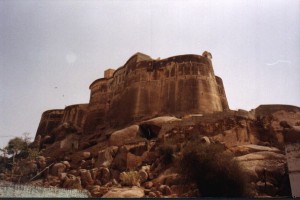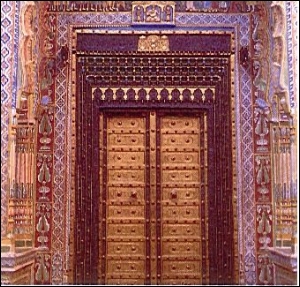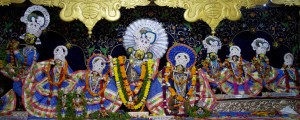Tourist Attraction of Sikar
Sikar is a city located in the Shekhawati region of Rajasthan state in India. It is the administrative headquarters of Sikar District. Sikar is a historical city and contains many old Havelis (big houses with Mughal-era architecture) which are a huge tourist attraction. It is 114 km away from Jaipur, 320 km from Jodhpur 215 km from Bikaner and 280 km from Delhi.
Laxmangarh Fort :- Laxmangarh also known as Lachhmangarh, is a fort town situated in the Sikar district of the western state of India, Rajasthan. It is strategically located on NH 11 and in the north of the district headquarters town of Sikar at a distance of 30 km. The town is a part of the Shekhawati region of Rajasthan. This region is well connected by railways to the other important cities and towns of Rajasthan. Rao Raja Laxman Singh of Sikar constructed a fort in Laxmangarh and in the nineteenth century this town came into being. Before becoming a town this place was a village by the name of Bergaon, which was the capital of the Meel Jats. Infact Laxmangarh has one of the most impressive forts of the Shekhawati region. The town has adopted the Jaipur city model, which has roundabouts and roads at right angles.
The Laxmangarh Fort is a beautiful piece of fort architecture which is a must visit for all those visiting Laxmangarh. Other than the fort the town is embellished with a number of havelis, which are decorated with Shekhawati fresco paintings. Even now Laxmangarh is a major center of Shekhawati art. Renowned havelis of Laxmangarh are Char Chowk Haveli, Sawant Ram Chokhani Haveli, Mirijamal Kyala Haveli, Bansidhar Rathi Haveli, Kedia Haveli and Sanganeria Haveli. The Ganeriwala Haveli located here is one of the most magnificent palaces of the Shekhawati region. The Radhi Murlimanohar Temple built in 1845 is a famous temple of the town with exquisite sculptures of deities on the external walls.
Harshanath Temple :- This Siva temple, situated a top the Harsaagiri hill, was built according to an inscription dated A.D. 973 by the Saiva ascetic Bhavarakta, alias Allata, during the reign of the Chahamana king Vigraharaja I. It was surrounded by numerous sub-shirnes, which like the main temple have been in utter ruins. In spite of its dilapidated condition the main temple is noteworthy for the excellent quality of structures and relief carvings. It faces east and consists on plan of pancharatha sanctum, joined to a rangamandapa with four central pillars and lateral transepts with kakshasana balustrades preceded by a separate nandimandapa and a distant torana in the same axis. Its pillars are profusely carved while inside the sanctum are sculptured on the west wall a central image of standing Parvati (labelled Vikata) engaged in panchagnitapa, flanked by female attendants swaying with lyrical grace.
Navalgarh Haveli :- Founded in 1737, by Thakur Nawal Singh, this town boasts of some of the finest frescoes in the Shekhawati region. The town has a colourful bazar and a fort. On the west of the fort are a group of havelis know numerically as aath havelis, aath meaning eight. The frescos on these havelis are not the best examples but they show the transition in painting styles through the periods. One of the paintings depicts a steam locomotive while other show mammoth images of elephants, horses and camels. Opposite these havelis is situated the Muraraka Haveli, which shows off some very fine painting including the miniature paintings from the Krishna legends. The haveli is has no occupants and the courtyard is usually locked unless some function is taking place.
To the north is Hem Raj Kulwal Haveli. Built in 1931 the haveli depicts at the entrance portraits of the Kulwal family and also that Indian leaders like Gandhi and Nehru. The windows are bordered by very colourful architraves.An ornate silver gate leads to the inner courtyard, which has some fine paintings mostly of religious themes. A local caretaker will let you in for a small tip. Quite close to it is the Khedwal Bhawan, which features some striking mirror and blue tile work at the entrance to the inner courtyard.
Khatu Shyam ji :– Thousands of devotees visit the temple during this annual fair, many of them for performing the 'Jadula' ceremony of their children, where the child 's head is shaven clean for the first time. An interesting legend attaches itself to this place of pilgrimage. During the time of Mahabharata, before the big battle, the grandson of Bhima approached Pandavas and Lord Krishna and asked them to let him fight for them. After a test of his strength, Lord Krishna felt that he was too powerful and if he participates in the battle,
everything will be finished off too quickly and will not be actually a justice. So he disguised himself as a Brahmin and asked Barbarik for his head as 'daan' (charity). Barbarik complied and cut off his head. Krishna was pleased with the sacrifice and blessed him so that he could watch the whole battle from the hillock, where his head was places. Lord Krishna also blessed him that in Kaliyug, he would be worshipped as Shyam (Lord Krishna) himself.
Madho Niwas Kothi :- The Madho Niwas Kothi was constructed by Madhav Singh. He also constructed the famous Victoria Diamonds Jubilee Hall. The walls of the kothi are decorated with golden paintings.
Radhadamodar Temple :- Sri Radha Damodar Mandir is an ancient temple established by Madhav Gaudiya Sampradaya. It was established by Srila Jiva Goswami in the year 1542 C.E. The deities here were served by Srila Jiva Goswami. Sri Radha Damodar deities were manifested by Srila Rupa Goswami, who gave them to his dear disciple and nephew-Jiva Goswami for service and worship. Later due to the terror of the muslim king Aurengzeb, Sri Radha Damodar were sifted to Jaipur for sometime and when the social conditions became favorable were brought back to Sri Dham Vrindavan in the year 1739 C.E. These deities have been served here since then. In Jaipur however a counterpart (pratibhu) of the deity was installed.
Some devotees are under the impression that the Deities of Radhadamodar in the Radhadamodar Temple in Vrndavan are not the original Deities of Srila Jiva Goswami. Some think that the original Deities now reside in Jaipur. However, this is not a fact. In 1670, when the Muslim fanatic Aurangazeb invaded Sri Vrndavana, he planned to destroy many temples and deface the Deities there. For this reason the principle Deities of Vraja were moved to the safe confines of the city of Jaipur in Rajasthan under the auspices of the Rajput kings. Most of the Deities remained there, such as Govindadeva, Gopinatha and Madana-mohana. The Radhadamodar Deities however returned to Vrndavana and have been worshipped there ever since. The Deities that replaced the originals in the temples of Govinda, Gopinatha and Madana-mohana are known as pratibhu-murtis which were installed and worshipped as substitute Deities by the Goswamis of those temples. All pratibhu-murtis are smaller in size than the original Deities installed by the acaryas, but it is worth noting that the Deity of Damodarji in Jaipur is smaller than the Deity in Vrndavana, thus further confirming that the original Deity of Sri Damodarji is in Vrndavana, whereas the pratibhu-murti is being worshipped in Jaipur today.
Before Sri Jiva’s disappearance in 1596, he left his Deities and library in the care of his successor Sri Krishna Dasa, the head pujari. The present sevaites are directly coming in line from his descendants.
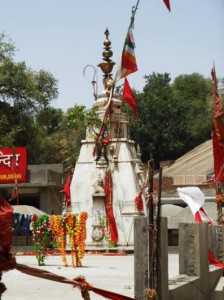
Jeenmata Dham is abode of Jeen Mata. Mata is an incarnation of the Durga. Her abode is nestled in the picturesque Aravalli hills in Raiwasa, District Sikar, State of Rajasthan in India, 115 kms from Jaipur-the state capital. The sacred shrine of JeenMata is belived to be thousands of years old. Millions of devotees throng the temple round the year. The congregation of devotees assumes a much colourful look during bi-annual Navratri celebrations – held twice a year in the solar calendar months of Chaitra(around February-March) and Ashvin(around October-November)-popularly known as the Navratris (nine holy days). A pilgrimage to the Holy Shrine of Shri Jeen Mata Ji is considered to be one of the holiest pilgrimages of our times. Mata is popular amongst its devotees as Moonh Maangi Muradein Poori Karne Wali Mata, which means, the Mother who fulfills whatever her children wish for. The temple has been constructed in the style of architecture adopted by Pratihar and Chauhan of Rajputs. There are twenty four pillars with panels of figures finely carved on them.
